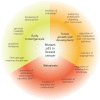The rebel angel: mutant p53 as the driving oncogene in breast cancer
- PMID: 22822097
- PMCID: PMC3483014
- DOI: 10.1093/carcin/bgs232
The rebel angel: mutant p53 as the driving oncogene in breast cancer
Abstract
Breast cancer is the most frequent invasive tumor diagnosed in women, causing over 400 000 deaths yearly worldwide. Like other tumors, it is a disease with a complex, heterogeneous genetic and biochemical background. No single genomic or metabolic condition can be regarded as decisive for its formation and progression. However, a few key players can be pointed out and among them is the TP53 tumor suppressor gene, commonly mutated in breast cancer. In particular, TP53 mutations are exceptionally frequent and apparently among the key driving factors in triple negative breast cancer -the most aggressive breast cancer subgroup-whose management still represents a clinical challenge. The majority of TP53 mutations result in the substitution of single aminoacids in the central region of the p53 protein, generating a spectrum of variants ('mutant p53s', for short). These mutants lose the normal p53 oncosuppressive functions to various extents but can also acquire oncogenic properties by gain-of-function mechanisms. This review discusses the molecular processes translating gene mutations to the pathologic consequences of mutant p53 tumorigenic activity, reconciling cell and animal models with clinical outcomes in breast cancer. Existing and speculative therapeutic methods targeting mutant p53 are also discussed, taking into account the overlap of mutant and wild-type p53 regulatory mechanisms and the crosstalk between mutant p53 and other oncogenic pathways in breast cancer. The studies described here concern breast cancer models and patients-unless it is indicated otherwise and justified by the importance of data obtained in other models.
Figures



References
-
- Horn H.F., et al. (2007). Coping with stress: multiple ways to activate p53. Oncogene, 26, 1306––1316 - PubMed
-
- Petitjean A., et al. (2007). Impact of mutant p53 functional properties on TP53 mutation patterns and tumor phenotype: lessons from recent developments in the IARC TP53 database. Hum. Mutat., 28, 622––629 - PubMed
-
- Feki A., et al. (2004). Mutational spectrum of p53 mutations in primary breast and ovarian tumors. Crit. Rev. Oncol. Hematol., 52, 103––116 - PubMed
Publication types
MeSH terms
LinkOut - more resources
Full Text Sources
Other Literature Sources
Medical
Molecular Biology Databases
Research Materials
Miscellaneous

